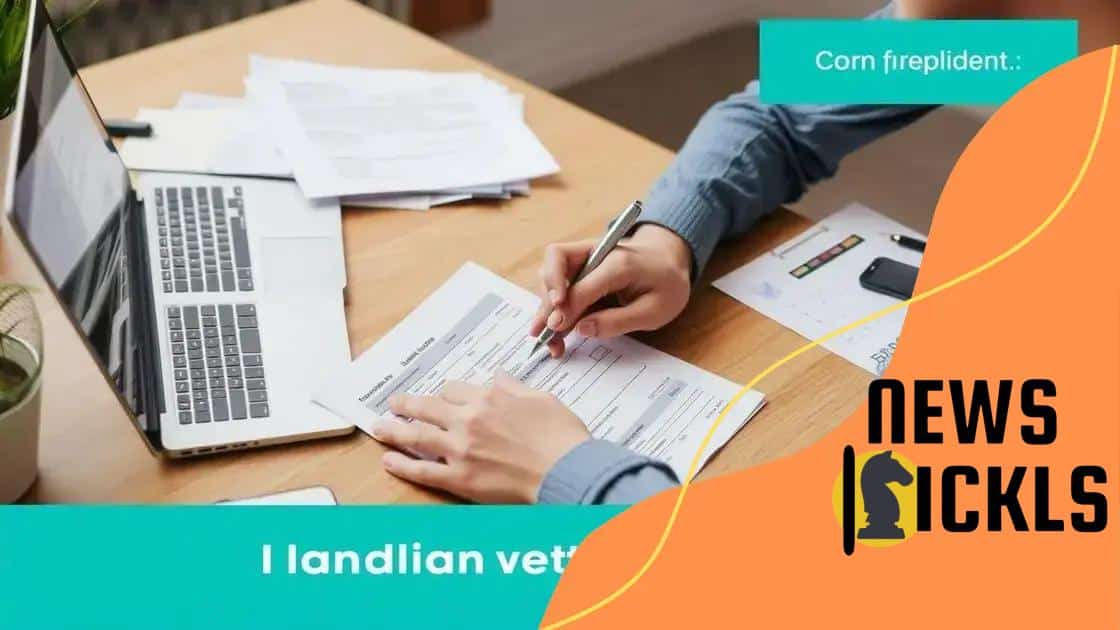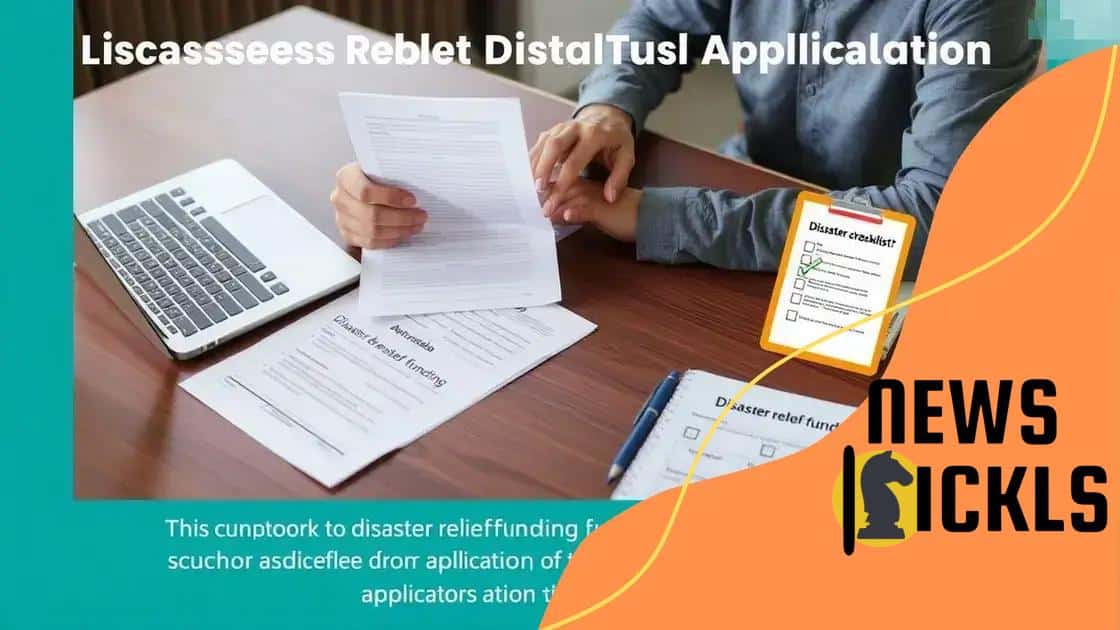How to apply for federal disaster relief funding in 2025

To apply for federal disaster relief funding in 2025, gather necessary documents, complete the application accurately through FEMA, and utilize available resources to avoid common mistakes during the process.
How to apply for federal disaster relief funding in 2025 is a crucial topic for those affected by disasters. Navigating the process can feel overwhelming, but with the right guidance, you can secure the help you need to rebuild and recover. Let’s explore the essential steps to ensure your application stands out.
Understanding federal disaster relief funding
Understanding federal disaster relief funding can make a big difference in times of need. This funding helps individuals and communities recover from disasters such as floods, hurricanes, and wildfires. Navigating the process can feel daunting, but knowing the basics will guide you through.
What is federal disaster relief funding?
Federal disaster relief funding is money provided by the government to assist those affected by disasters. This funding aims to help rebuild homes, restore livelihoods, and provide necessary resources for recovery.
Types of assistance available
There are various forms of assistance under federal disaster relief funding:
- Individual Assistance: Helps individuals and families recover from disaster-related losses.
- Public Assistance: Assists state and local governments in repairing damaged infrastructure.
- Hazard Mitigation Assistance: Funding for projects that reduce future disaster risk.
Knowing which type of funding you qualify for is essential for effective recovery. Each program has specific guidelines and requirements.
To access federal disaster relief funding, you typically need to apply through FEMA, the Federal Emergency Management Agency. You can submit an application online or through phone assistance. Remember, details like your location and the nature of the disaster can impact your eligibility.
Eligibility criteria
Eligibility for federal disaster relief funding depends on various factors:
- Your home location must be declared a disaster area.
- You must show proof of identity and ownership or occupancy.
- Document your losses with receipts or images.
Taking these steps can enhance your chances of receiving aid. It’s important to gather all necessary documentation and information beforehand to streamline the process.
Keep in mind that federal disaster relief funding is not just for homeowners; renters may also qualify for assistance. Understanding the full scope of what is available can empower you to take informed steps toward recovery.
Eligibility requirements for funding
Eligibility requirements for federal disaster relief funding are crucial to understand for anyone seeking assistance after a disaster strikes. The government sets specific criteria that applicants must meet in order to qualify for funding.
Who qualifies for assistance?
Generally, individuals and families affected by disasters can apply for funding, but they must be able to prove their losses. Here are some key points to consider:
- Residency: You must live in a designated disaster area.
- Disaster impact: You should have experienced damage to your property or personal belongings.
- Proof of occupancy: This includes showing that you either own or rent the space affected.
These requirements ensure that funds are given to those who truly need help. Collecting the necessary documents can also simplify the application process.
Required documentation
Applicants must provide certain documentation as part of their application. Here are important items to prepare:
- Identification: A government-issued ID or driver’s license.
- Proof of loss: Pictures and receipts of damaged items can strengthen your case.
- Income verification: Pay stubs or tax returns may be needed to evaluate your financial situation.
Gathering these documents ahead of time can save you from delays. It’s advisable to keep copies of everything submitted.
Additionally, it’s good to remember that not all losses may qualify for funding. Items that were not insured may not be reimbursed. However, assistance programs aim to cover the greatest number of essential losses possible.
Steps to complete your application

Completing your application for federal disaster relief funding is an important step in your recovery process. It’s crucial to follow the right steps to ensure your application is successful.
Step 1: Gather necessary information
The first step involves collecting all the information you need. This includes details about your identity, your property, and the disaster itself. Make sure to have:
- Your Social Security number.
- Address of the damaged property.
- A brief description of the disaster.
Having this information ready will help streamline the application process.
Step 2: Complete the application
Next, you will need to fill out the application form. You can apply online through the FEMA website or call their helpline for assistance. Pay special attention to:
- Providing accurate information.
- Describing your losses clearly.
- Double-checking all entries before submission.
Incorrect information can delay your application or lead to denial, so accuracy is vital.
Step 3: Submit your application
After completing the form, submit it as per the guidelines provided. If you’re applying online, follow the prompts to ensure everything is submitted correctly. If applying by phone, have all your information accessible for the representative.
Step 4: Follow up
Once your application is submitted, keeping track of its status is essential. You can do this by:
- Contacting FEMA for updates.
- Checking online through your FEMA account.
- Ensuring you respond promptly to any follow-up requests for information.
This proactive approach will help ensure you receive your funding as quickly as possible, allowing you to rebuild your life after a disaster.
Common mistakes to avoid when applying
When applying for federal disaster relief funding, avoiding common mistakes can significantly improve your chances of success. Many applicants unknowingly make errors that can delay their funding or lead to denial.
Not reading the guidelines
One of the most common mistakes is not thoroughly reading the application guidelines provided by FEMA. Each program has specific requirements that you must follow closely. Make sure you understand:
- Eligibility criteria for your situation.
- Required documentation for your application.
- The application deadlines you must meet.
By familiarizing yourself with these details, you can avoid unnecessary setbacks.
Providing incomplete information
Another frequent error is submitting applications with incomplete or inaccurate information. This can include:
- Missing signatures or dates.
- Not including all required documentation.
- Incorrectly filling out forms.
Double-check your application before submission to ensure every section is complete and accurately reflects your situation.
Ignoring communication from FEMA
After you submit your application for disaster relief funding, it’s essential to stay attentive to any correspondence from FEMA. Ignoring emails or letters can result in delays or additional requests for information. Being prompt in your responses can help keep the process moving smoothly.
Missing out on appeal rights
If your application is denied, it’s vital to know that you have the right to appeal FEMA’s decision. Failing to pursue this option can result in losing out on valuable assistance that you might qualify for. Be proactive and consider seeking help from local organizations that assist with the appeal process.
By taking care to avoid these common mistakes, you can increase your chances of receiving the help you need to recover from a disaster.
Resources for additional help and information
If you find yourself needing extra support while applying for federal disaster relief funding, there are many resources available to help you navigate the process. Knowing where to turn can make a big difference in your recovery journey.
FEMA resources
The first place to start is the Federal Emergency Management Agency (FEMA) website. It offers a wealth of information, including:
- Detailed guidelines on how to apply.
- Frequently asked questions (FAQs) to clarify common doubts.
- Tutorials and videos explaining the application process.
Checking the FEMA site regularly can keep you updated on any changes in procedures or new assistance programs.
Local organizations
Many local organizations assist those applying for disaster relief. They can provide hands-on help and guidance tailored to your community’s needs. Here are some types of organizations to look for:
- Nonprofits focused on disaster recovery.
- Community action agencies that offer financial assistance.
- Legal aid services that can help with the appeals process if needed.
Connecting with these organizations can offer personalized support and resources specific to your area.
Online forums and support groups
Online forums and social media groups can also be valuable. Engaging with others who have gone through similar experiences can provide emotional support and practical tips. You might find:
- Advice on completing applications.
- Shared experiences that offer encouragement.
- Links to additional resources or contacts.
These platforms can create a sense of community, ensuring you don’t feel alone in your recovery.
State and local government agencies
Don’t forget about your state and local government agencies, which often have additional resources available for disaster relief. They can provide information on:
- Emergency management services.
- Local grants or funding opportunities.
- Community events focused on recovery and support.
By utilizing these various resources, you can gain the knowledge and assistance needed to successfully navigate your application for federal disaster relief funding.
FAQ – Frequently Asked Questions about Federal Disaster Relief Funding
What types of assistance are available through federal disaster relief funding?
Federal disaster relief funding offers several types of assistance including Individual Assistance for affected households, Public Assistance for local governments, and Hazard Mitigation Assistance to reduce future risks.
How can I apply for disaster relief funding?
You can apply for disaster relief funding through the FEMA website, by phone, or in person at designated assistance centers. Ensure to gather all necessary documents beforehand.
What common mistakes should I avoid when applying?
Common mistakes include providing incomplete information, not reading the guidelines, and ignoring communication from FEMA. Double-check everything before submission to avoid delays.
Where can I find additional resources for help with my application?
You can find additional help on the FEMA website, local nonprofit organizations, online support groups, and state or local government agencies that offer assistance.






